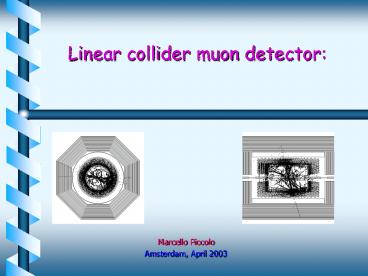Linear collider muon detector: - PowerPoint PPT Presentation
Title:
Linear collider muon detector:
Description:
Started running with V 3.07 in Brahms. Few preliminary results ... The new Brahms release ... The new Brahms release (cont.) Marcello Piccolo. 5. Muon ID with ... – PowerPoint PPT presentation
Number of Views:21
Avg rating:3.0/5.0
Title: Linear collider muon detector:
1
Linear collider muon detector
- Marcello Piccolo
- Amsterdam, April 2003
2
Agenda
- Simulation
- Started running with V 3.07 in Brahms. Few
preliminary results - Results available also from the other side of the
Atlantic.reasonable agreement. - RD Dedicated real work started or starting on a
very short time base.
3
The new Brahms release
- The (Fortran) Code to full simulate the Tesla
detector has been upgraded (thanks to Ties and
Vasily) - W-Si calorimeter option has been implemented
- Had Cal is based on the scintillator design.
- The Design Report muon detector has also been
folded in. - As of now it is possible to write a complete hit
file containing - Tracking detectors
- Calorimeters
- Muon detector
4
The new Brahms release (cont.)
5
Muon ID with dE/dx Correction
6
Here are the overall resultsZH events _at_500 GeV
The four spectra refer to Black generated
primary particles Red generated
m Green identified m Blue misidentified p
7000 evts
7
Some RD points on the EU side of the Atlantic
- There are few issues that need to be addressed
- RPC (either bakelite or glass) have to be
certified as rate capable. - Gas mixes that grant to be neutron transparent,
especially for the end-caps have to be found. - Working regimes have to be investigated in
different rates environment.
8
Conceptual view of the facility
9
Simulated beam energy spectra
10
Particle multiplicity
11
Efficiency bidimensional mapA good bakelite RPC
- The overall efficiency
- For this module is
- (92.7.05 )
- Cosmic ray data
12
Efficiency bidimensional mapGlass RPCs
13
Plateaux for two 1.1 m2 Glass RPCs
Turn on for streamer pulses on Glass
RPC. Detector dimensions 1x1.1 m2 Gas mix 60/35/5
Ar/Fr/Isob
14
Transverse and longitudinal efficiency
distributions Glass RPC
The tube structure of the Glass RPC is
apparent in the first plot where boundaries
between different Detectors can be seen as a
drop In the efficiency. The distribution along
the other coordinate is flat as expected
15
R D is Needed Why?
- How good is muon ID? For full LC menu?
- Does E-flow benefit from m Cal?.
- Requires integration with barrel and forward
tracking and calorimetry, structural Fe,
solenoid, mechanical support, cables, etc. - Robust design parameters - must be understood,
optimized, cost estimated, reviewed. - Best m detector design?
16
Mechanical Engineering
- Statics OK with 47T plates
- Bolting appears to be possible structurally.
- Open questions
- Machined Fe?
- Groove fitted?
- Spokes a la CMS?
- Bolted?
- Opportunities for further ME work here.
17
Extruded Scintillator RD at Fermilab
- Studied Wavelength shifting (WLS) fiber readout
of scintillator extrusions for possible future
large scale detectors - Scintillator MINOS extrusions
- 1 X 4 cm grooved
- TiO2 reflector
- Scintillator KEK prototype
- 1.2 X 2.5 cm hole down the middle
- TiO2 reflector
- WLS Kuraray Y11
- 1.2 mm 175 ppm (MINOS Standard)
- 1.0 mm 200 ppm
- 0.5 mm 200 ppm
- Photodetector - Visible Light Photon Counter
(VLPC) - Used D0 HISTE VI devices
- QE80-85
- Gain 60,000
Alan Bross March 2003
18
VLPC Tests with MINOS Scintillator
- 1.2 mm WLS fiber (MINOS) results using VLPCs.
Tests of 1.0 0.5 mm fibers, etc. Want to try
co-extr of scint fiber.
MINOS Ref. Value (sum)
Alan Bross March2003
19
Outlook and Conclusions
- Simulation tools specific to the muon filter are
being developed both in Europe and U.S. - Preliminary results seems to be in comfortable
agreement. - RD programs (again specific) to muon detector
have started and will be in full swing in the
coming months. - Interesting developments also relevant for the
hadronic calorimeter will be pursued.































